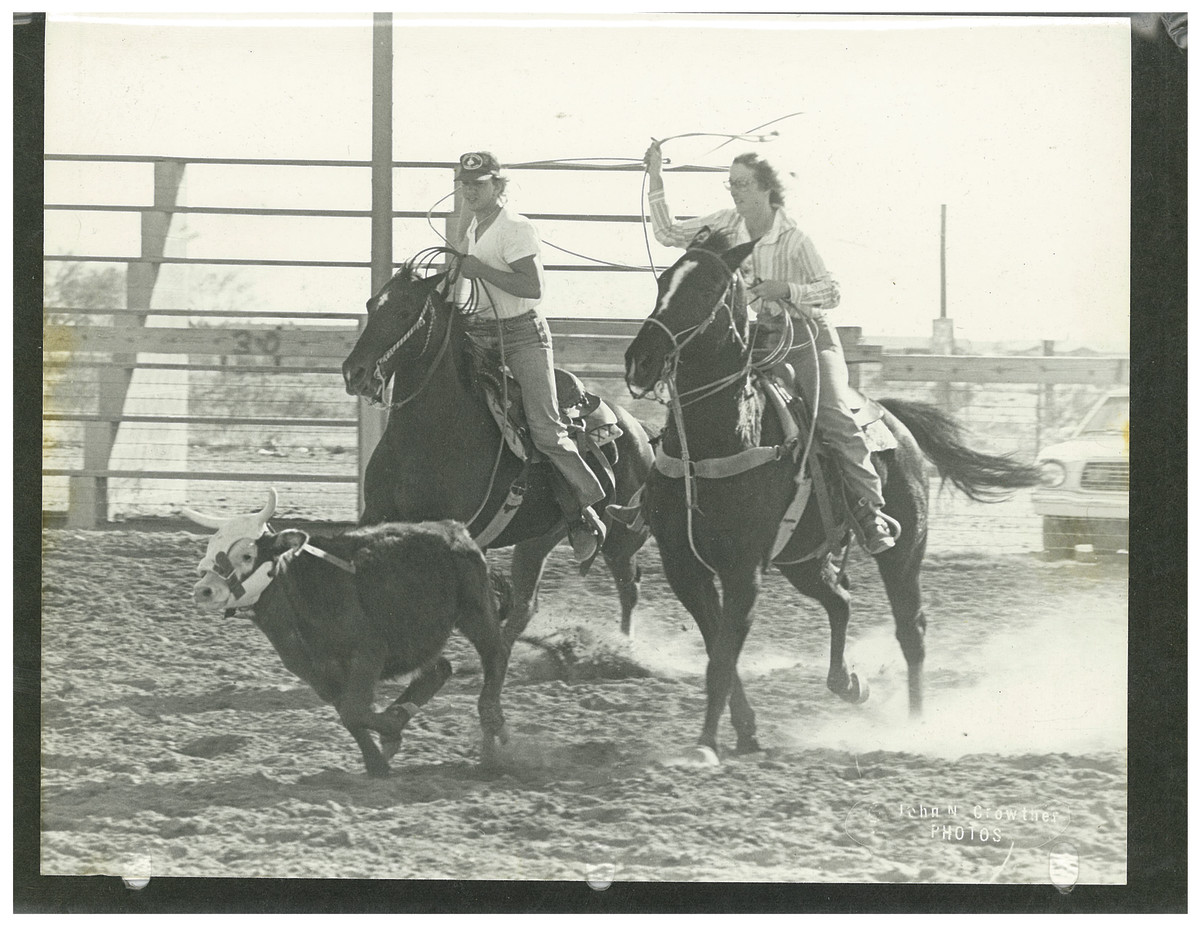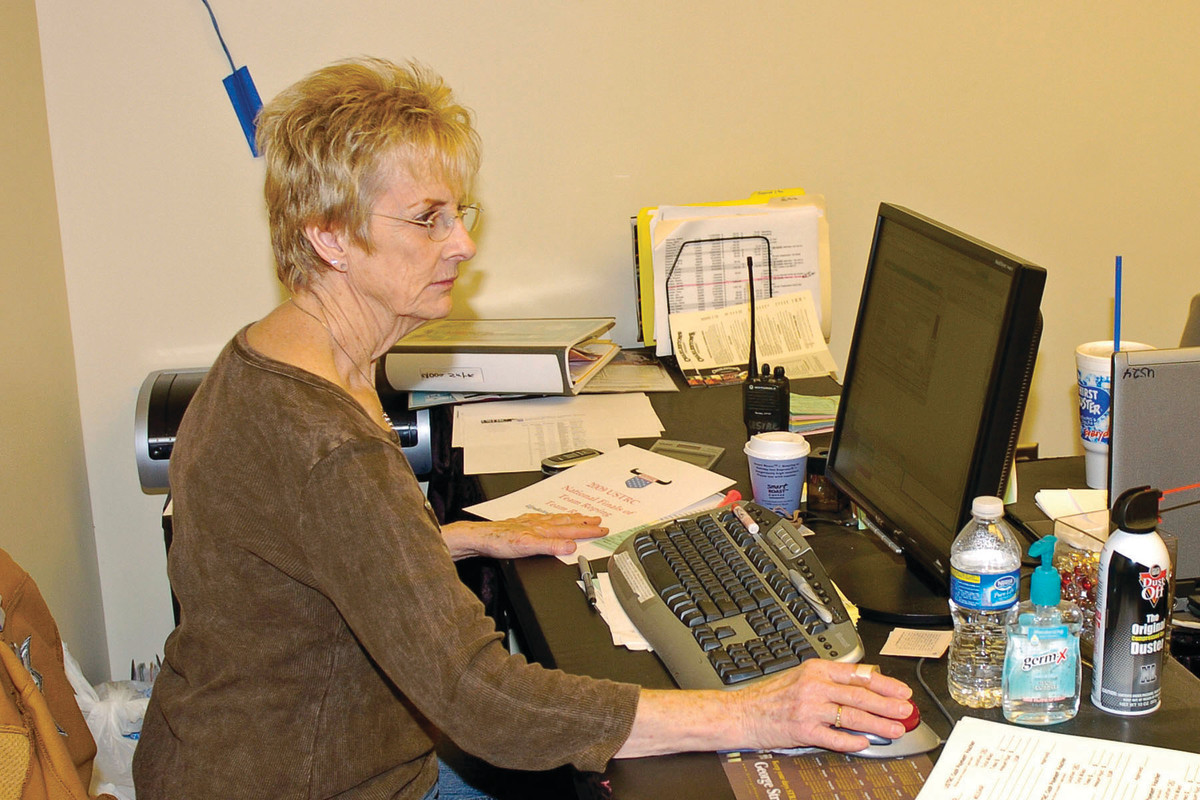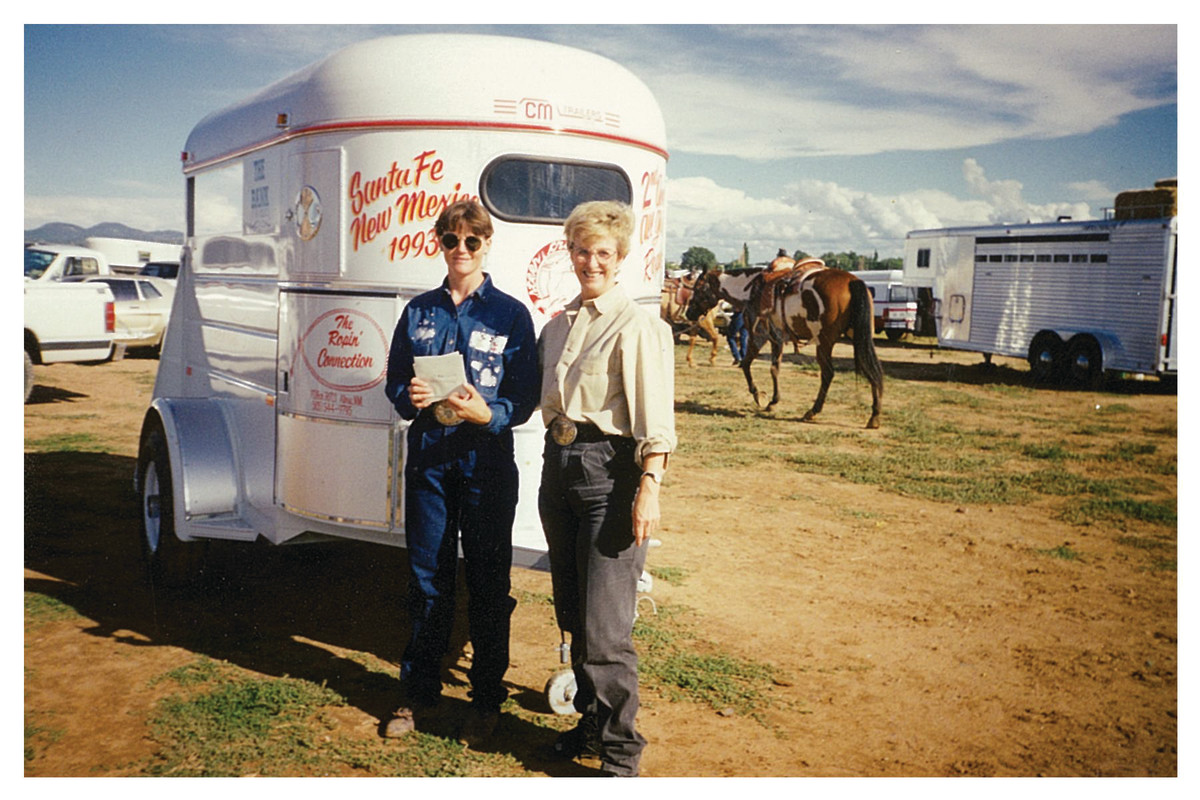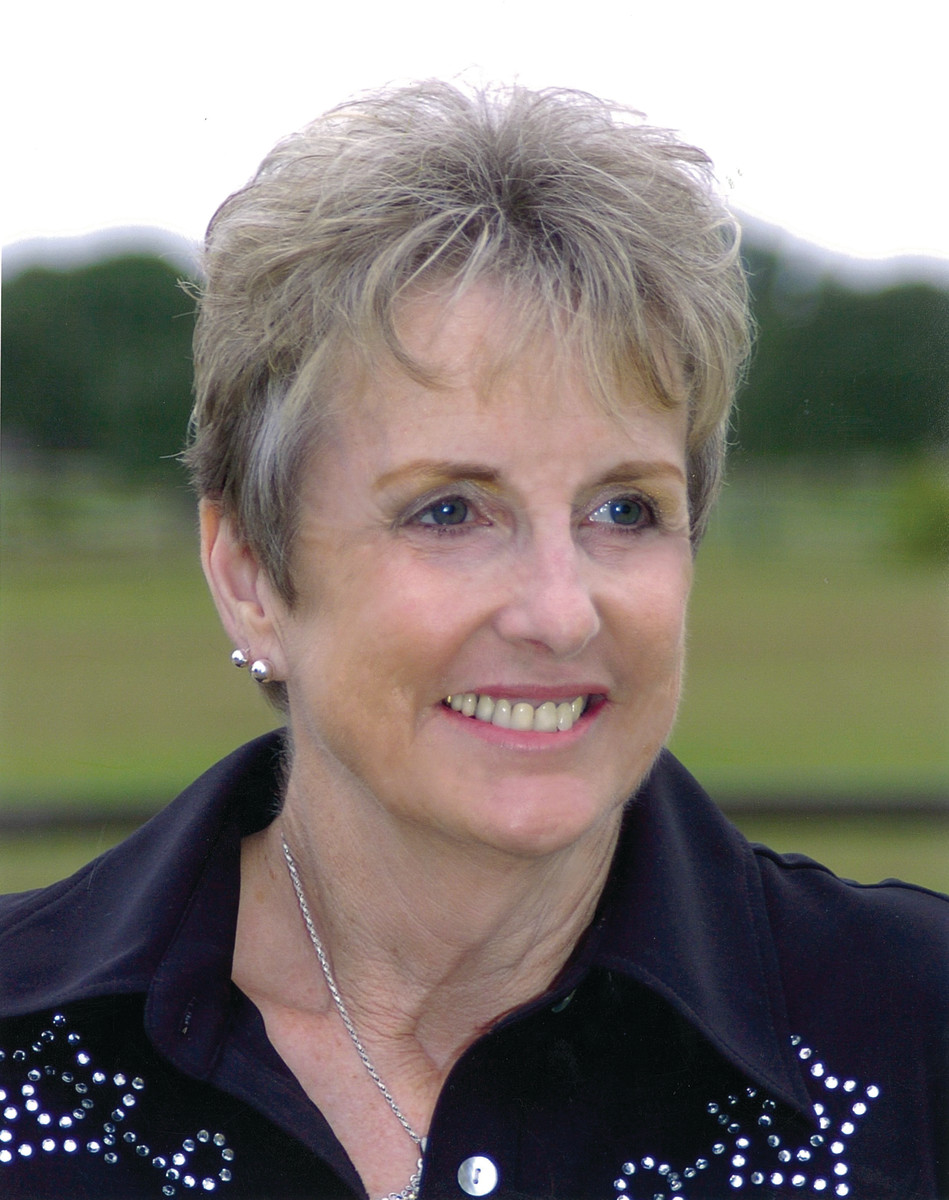In the late 1980s, then-lobbyist Denny Gentry witnessed Judy Dawes running the New Mexico governor’s office in Santa Fe. He already knew her from team roping circles, but that day, he discovered the person that could help him get his big idea off the ground.
“Today, she’s one of the last, hard-core secretaries,” Denny said. “When I saw Judy handling that office, I knew I had found the first employee. That was who I wanted helping me.”
The big idea, of course, was a recreational team roping association with a number system. What began as the New Mexico Team Roping Championships, in short order grew to be the United States Team Roping Championships, and Judy was there at every step and misstep, relentlessly heaving the coals onto a sometimes out-of-control fire that became the amateur team roping of today.

Now on the eve of her 75th birthday, Judy grew up in Wyoming and began roping competitively when she was 35, and often offered up her secretarial services at the ropings in order to support her new-found habit.
“I started working ropings back in the early ’80s,” Judy said. “And in Arizona, I worked for Jim Riley at the original Dynamite Arena, so that’s where I really got my start and made some key connections.”
When a subsequent move took Judy to New Mexico and she was looking for work, it was that experience that got her foot in the door with the campaigning politician.
“They said, ‘Do you know computers?’,” Judy remembered, “And I said, ‘Sure!’ But I had absolutely no idea. I went and took a crash course on how to turn on a computer and do different things. But, of course, I walk into work and their computers are completely different from anything I’d ever seen. It was a blessing, though, because they sent me to IBM school to learn.”
That opportunity, combined with Judy’s first-hand knowledge of the team roping business, opened the door for the development of the first US classification system. By the time the USTRC partnered with Gary Poythress at Rodeo Computer Services to build a database, they were already handling 15,000 ropers on a spreadsheet that Judy had designed. It’s an accomplishment that marks both the most challenging and the most successful aspects of her time with the USTRC.
“At our first New Mexico Championships, I could see how successful it was going to be,” Judy recalled. “Between the participation and how well received it was with the ropers; for them to be able to rope in their skill level … they fell in love with it.”
By 1990, the first USTRC finals was being planned, even though the organization had yet to be able to afford itself. Ropers and producers were signing on and there was no lack of enthusiasm for the association, but behind the scenes was an altogether different story. Denny’s wife, Connie, was using her singular salary to pay Judy’s (very modest) salary and to the organization she and her husband were operating from their garage afloat. But the freight train that was the USTRC was rolling, charging down the mountain.
“In the ’90s,” Denny said, thinking back to the early days, “the USTRC was rockin’. We would put on a three- or four-day events in Phoenix, Scottsdale, or Albuquerque and have 3,300–3,600 teams in it, and we would run three full go-rounds. Compare that to right now where the World Series Finale has 3,900 teams—just 300 more—and it takes seven days.”
And according to the ropers, it was a golden era of good times. But behind the curtain, it was hair-on-fire madness that only the hardiest could handle.
When the decision was made to build a national database, R.W. “Digger” Howard, who founded the Original Team Roping Association in 1987 and had a handicapped number system, graciously shared his list of Texas ropers, giving the USTRC a solid foundation to begin building their network. It marked the beginning of endless hours spent on the phones getting information on ropers across the country, an endeavor that had not yet been pursued until then.
At the same time, desktop computers were becoming common workforce tools, and Judy began teaming up with programmers to better communicate how the database needed to operate to best serve the team roping community. And until the database was built, everything was being done by hand.
Judy was traveling across the country sharing her skills and expertise with secretaries and producers alike, helping them get their newly sanctioned USTRC ropings off the ground and online.
“Judy would log somewhere around 50,000 miles a year going to all those ropings,” Denny mused. “We were putting on 200 ropings a year and I needed her training the secretaries in all those places. Well, we did not have the technology back then and we would be stringing cable for x-hundred feet and carrying the sheets on golf carts from one arena to the next. That’s how simplistic it was. Judy would tell the secretaries they needed to back up the computers, and would give them a packet with carbon paper. That was our back-up system: triple carbon paper with all the sheets written out long-hand!”

It’s been long enough to look back now and see the humor in all of it, but back then, making the magic happen required true mettle.
“Denny was real good about sending me to different parts of the country,” Judy began, “but I didn’t know what I was getting into. All-Around Cowboy Champion Paul Tierney was putting on a roping up in Belle Fourche, South Dakota, and it’s just out in a big pasture. He says, ‘I have a trailer for you for an office,’ and pulls up a four-horse stock trailer and gives me a card table to work on. When I suggested a chair, he asked, ‘Will this work?,’ and gave me a five-gallon bucket. So, we rigged up electricity for my computers and that’s where I took entries.
“Denny called me,” Judy recounted, chuckling, “and he said, ‘How’s it going? How many stalls do they have?’ I said, ‘Denny, there are no stalls here. There are hobbles for when they turn their horses out in that 90-acre pasture!’
Connie speaks similarly of their first event in Arizona, which was met with monsoon rains.
“Denny was out in the rain trying to build pens for the cattle,” she exclaimed, “and Judy and I were patching holes in ceiling to try to keep the water out!”
“Now they have all these fancy facilities, but that’s how it started,” Judy concluded. “It’s come a long way.”
Though desktop computers were hitting their stride, the USTRC developed long before email and other forms of instant communication came into play, making landlines and direct mailings the information mules of the time.
“We worked a lot at night,” Judy explained, “because that was the only time to be in contact with the ropers. Back in the day, you didn’t just call anybody up on any hour of the day or night. We had to wait and go in the office in the evening and catch them when they’d come in for supper, or home from work, because there weren’t any cell phones.”
The same went for mailings, which, in the beginning, were sent to each roper for each individual roping.
“Lots of mailings went out on Connie’s kitchen table,” Judy continued, “and I was burning the candle at both ends. The kids suffered, but I was the sole provider. I would make sure they were safe and sound and then I would leave home at midnight and go to the office and work until the wee hours of the morning and catch up on stuff and then go back home and make sure they got off to school.”
Judy was raising her two daughters at the time, Jody and Chanteal, who often lent their mom a helping hand.
“I’ll never forget,” Judy recounted fondly, “Jody was in high school and we were stuffing mailings for Texas, and she goes, ‘Mom, do you realize how many people are named Bubba in Texas? Look at all these Bubbas!’”
(Fun fact: Today, there are 85 registered ropers named Bubba in Texas.)
The mailings, which would eventually lead to the creation of SuperLooper, were grunt work. But so was most of the work in the beginning, when it was just Judy, Denny, and Connie.
“I think back to times when prize saddles would show up unfinished,” Denny said. “The three of us would sit down on the floor and paint the letters on the saddles all night. I can’t tell you how many nights we would finish when the sun was coming up. Judy’s deal was always that she would do whatever the hell had to be done to make things work.”
It’s a conviction that Judy applied to every aspect without exception, even her own roping.
“I think it was in the early ‘90s, I was roping with World-Champion heeler Dennis Motes in Guthrie in the shoot-out,” Judy reported. “We had our two steers down really good, and some catastrophe happened at the office. I ran in there to take care of whatever it was, and as I’m helping solve whatever was going on, I heard them call, ‘Third call. Dawes and Motes. Turn ’em out.’”
Thinking that Judy gave up what may have been a once-in-a-lifetime arena opportunity is a bit gut-wrenching, but she stands solid in her decision to this day.
“That was back in the day when you didn’t get your steers back,” she went on. “But we set a precedent. I know some of the ropers thought some of the rules were a little harsh, but we just had to say no. It set a precedent, and that’s what made it successful—following our guidelines and enforcing them. If we had just been lackadaisical, we could have never set the kind of standard that we needed then and remain true to today.”

Still, between drawing hard lines and working unforgiving hours, Judy established herself as the go-to resource in the organization.
“Her greatest skill is her resourcefulness,” Connie reflected. “She had such a strong work ethic and, if she needed to learn how to do something, she’d just stick with it. And now, she’s probably the most well-known secretary in team roping.”
“Judy made about 10,000 people think that she was their personal secretary” Denny added. “It was good and bad because they wouldn’t talk to anybody but her, so she made her job double-tough over the years because she wanted to take care of her people. But it’s no lie, over the course of that 30-year run, there were thousands of them that believed Judy was the only one that could take care of their business.”
When asked how she did it, Judy humbly chalks up her status to the fact that she had simply been around long enough to know how all of it worked.
“It’s just because, when you grow with a company, you have all the answers because you’ve been on the planning end of it and the trial-and-error part of it. And there was a lot of trial and error back in those days—trying to try something that might work. So you just grow that knowledge.
“But,” she went on, “the main thing is just take care of your customer. The rest will fall into place as long as you’re taking care of your customers. They’re your bread and butter in this organization, even the unpleasant ones. And there are a lot of those, but the good override the bad. My attitude was always that without them, I wouldn’t have a living and we wouldn’t have the successful team roping we have today, so we have to take care of them, too.”
Judy knew answers to every angle that team ropers could possible throw at her,” Arkie Kiehne, who worked with Judy in and out of the USTRC for 25 years, revealed. “And, believe me, they can throw a lot of angles.
“She’s The Duke. She’s the John Wayne of team roping, as far as I’m concerned. She could do anything in any part of the organization; and she expected it to be done right. And if it wasn’t, she’d dang sure tell you.”
It’s no secret that Judy could pull a don’t-mess-with-me card from time to time, especially at the end of big roping, when the office was shutting down, and it was finally time to go home … which is exactly when a 13-year-old Ben Clements decided to collect the check for the first roping he’d ever won.
“I was terrified,” Ben, who now handles event scheduling and facility assistance for the USTRC, said of his first encounter. “And when I began announcing years later, I would check if she was going to be working there because she had left such an impression on me.”
What Ben soon came to realize is that you can’t navigate the team roping world without rubbing elbows with Judy. (“She’s kind of like Cher,” Ben explained. “It’s not Judy Dawes. It’s Judy.”) They began working the same ropings, and when Ben hired on at the USTRC in 1997, it was no time at all before they were traveling the miles together and building a lifelong friendship. When the Gentrys sold the USTRC to Equibrand in 1999, Ben and Judy made the move from Albuquerque to Stephenville together.
“If there had been no Judy Dawes,” Ben supposed, “I think the team roping industry would have felt that transition. She was the constant that didn’t change. She was able to help the powers-that-be learn the industry while helping the team ropers feel comfortable about the changes.”
For Ben, who has literally traveled from coast to coast with Judy, a woman whom his wife regards as a mother and his children regard as a grandmother, her retirement is bittersweet.
“I’m happy for her,” he confirmed, “but in another way, it’s a loss for the team roping industry. She’s an awesome ambassador to our sport and she’s been the mother hen to all the secretaries, timers, announcers, everybody, and has herded them in the right direction. She’s a tough woman, but deep down, she’s caring and passionate, and a stickler for organization and success.
In the nearly 30 years spent with the USTRC, Senior Customer Service is as close to an official title as she was ever given. She suggests that “Jack of all trades, master of none” may have been just as applicable—as there likely isn’t a title that could possibly incorporate all that she took responsibility for—but service to others is certainly a trademark.
“Judy Dawes is an icon in this industry,” Ken Bray, Equibrand’s president and Judy’s boss of 17 years, posited. “She has dedicated her life to the sport and her contributions helped shape and transform team roping into the sport it is today. She is a stickler for getting it right, but she is a friend to all.”
It’s a fact that certainly aids in Judy’s transition away from the USTRC.
“People are always needing me to do something,” Judy commented on her new post-retirement life. “It’s not like I’m not still busy. I’m a babysitter. Have been my whole life, taking care of everybody.”
It’s a tradition that she is happy to continue with her own grandchildren—Faye, 5, and 12-year-old Billy.
“Billy is very busy in sports and athletics,” Judy stated. “And Faye decided she wants to be a barrel racer. We do a lot of stuff together because I have time now and I’m home more.”
For those who may be wondering what team roping will look like without Judy, rein it in. That’s not what’s happening.
“I will continue to stay involved as long as I can drag my leg out the door,” Judy asserted. “I do miss the day-to-day rapport with the ropers, but I still work a lot of the ropings. I still have a lot of the producers calling me to work. So, as long as I enjoy it. Because that’s where the rest of my family is—on the road out there in every part of the country.”
In looking back at her time with the USTRC, Judy laments that she didn’t keep a journal (though who could imagine keeping a journal in addition to everything else she was managing) to help her keep track of all the stories and the people who have shaped her life.
“There are so many people who I have in my memory that have influenced me and made me grow; I don’t know where to start,” Judy admitted. “We’ve certainly been a lot of miles, made a lot of memories, and survived a lot of disasters—tornadoes, floods, hurricanes. But it’s kind of like childbirth. You remember the good parts.

“I tease Denny and say, ‘I wish I’d had your crystal ball since you always seem to know what’s down the road.’ And the ropers would never have much of a clue what was going on behind the curtain. All they knew was their name was called and they got to rope.”
It’s a truth Denny marvels at, as well.
“The majority of it happened because a small core group of people spent more time and more effort than common sense should allow,” he noted. “I always thought it had to be divine intervention that brought all of them together. Total commitment and dedication created the modern day industry. Judy would have to be at the top of that list.”
“She just loves team roping,” Connie followed, “and this community has been her life. She was on the front line since day one and, often, a person will harden and burn out from it all. But for Judy, it’s been the opposite. Her time with the roping community has given her grace.”





